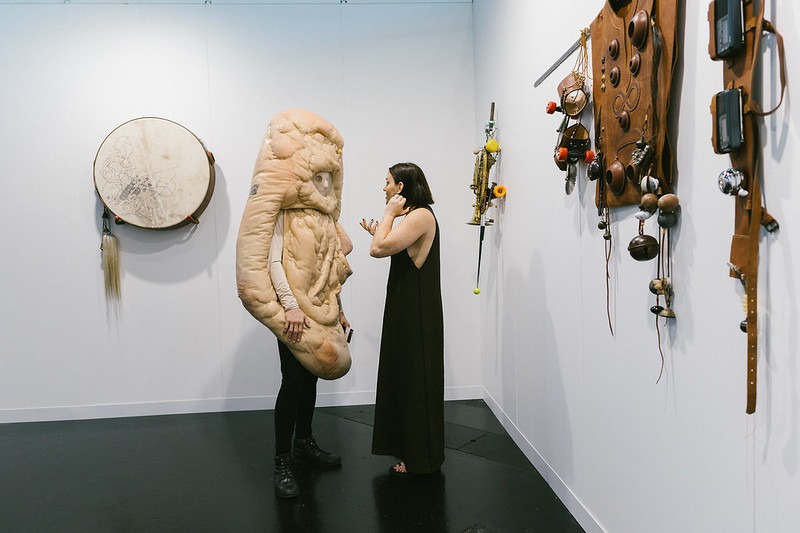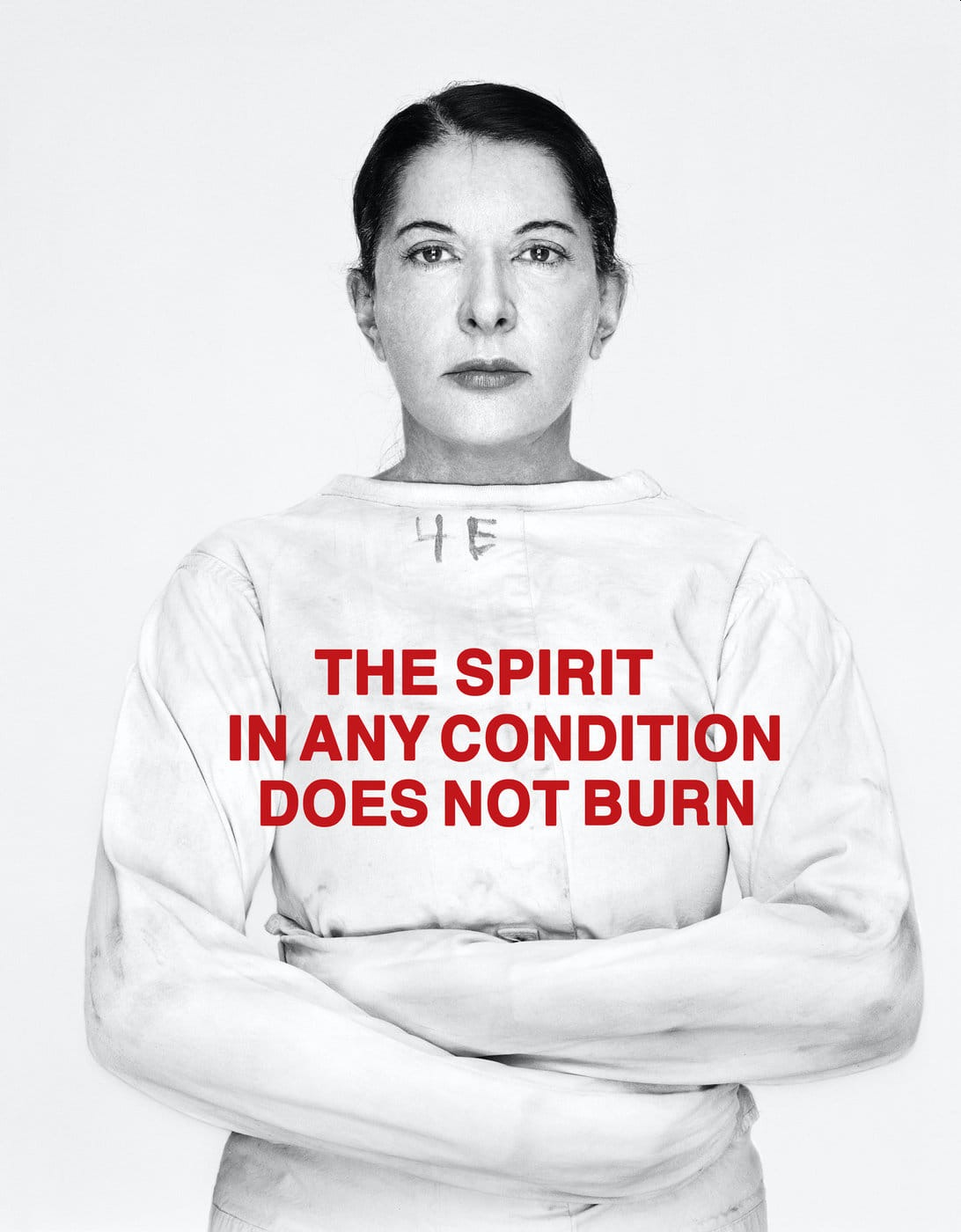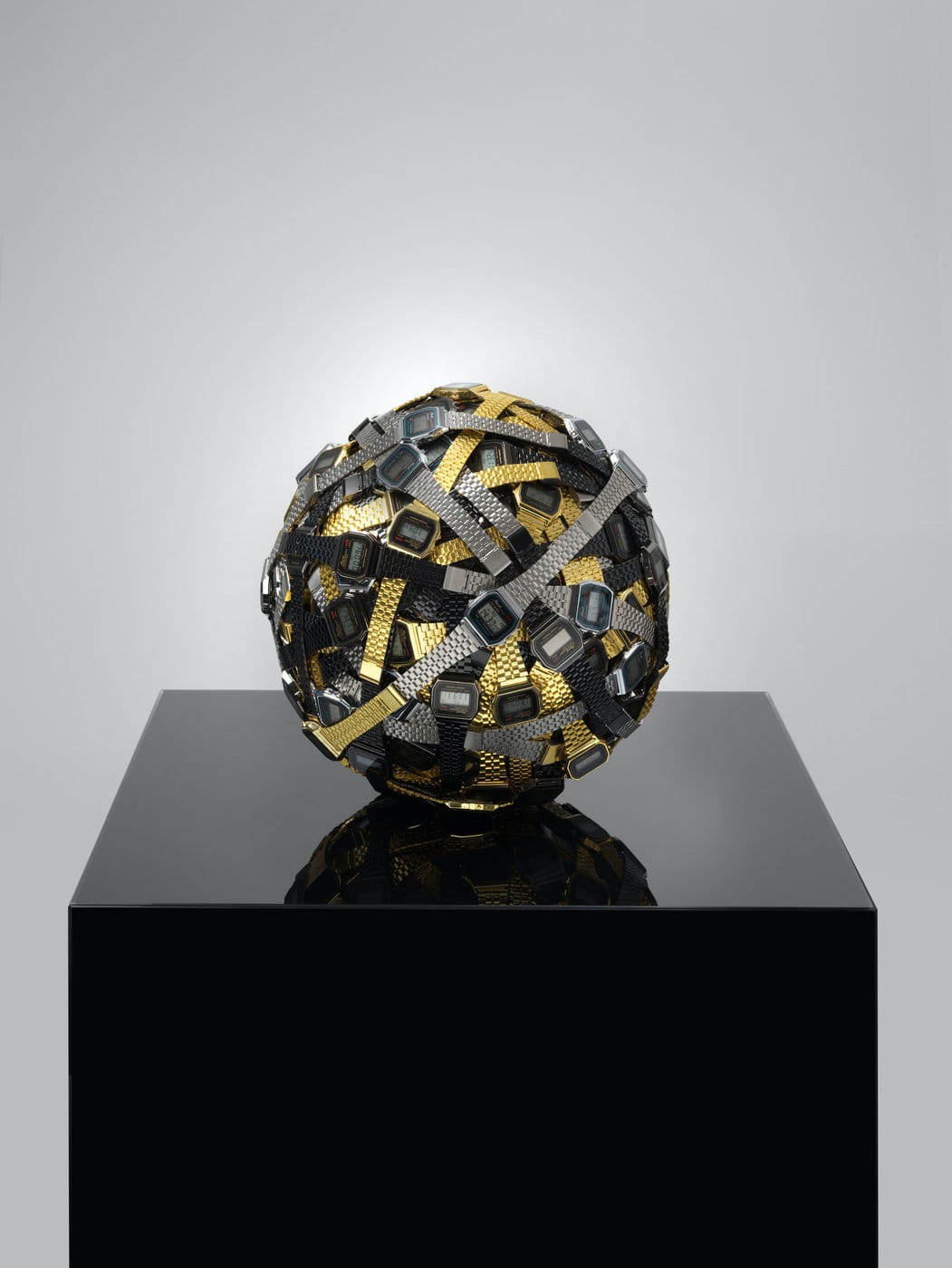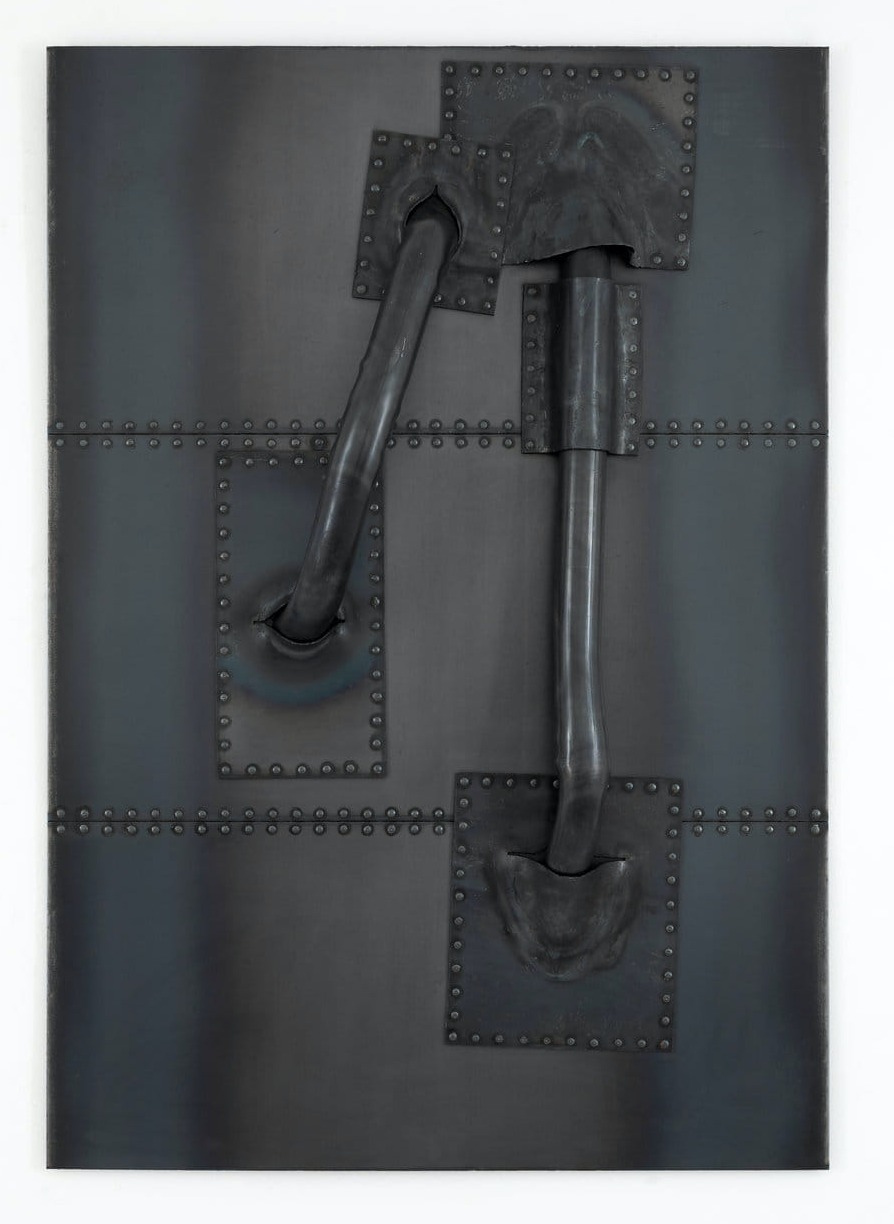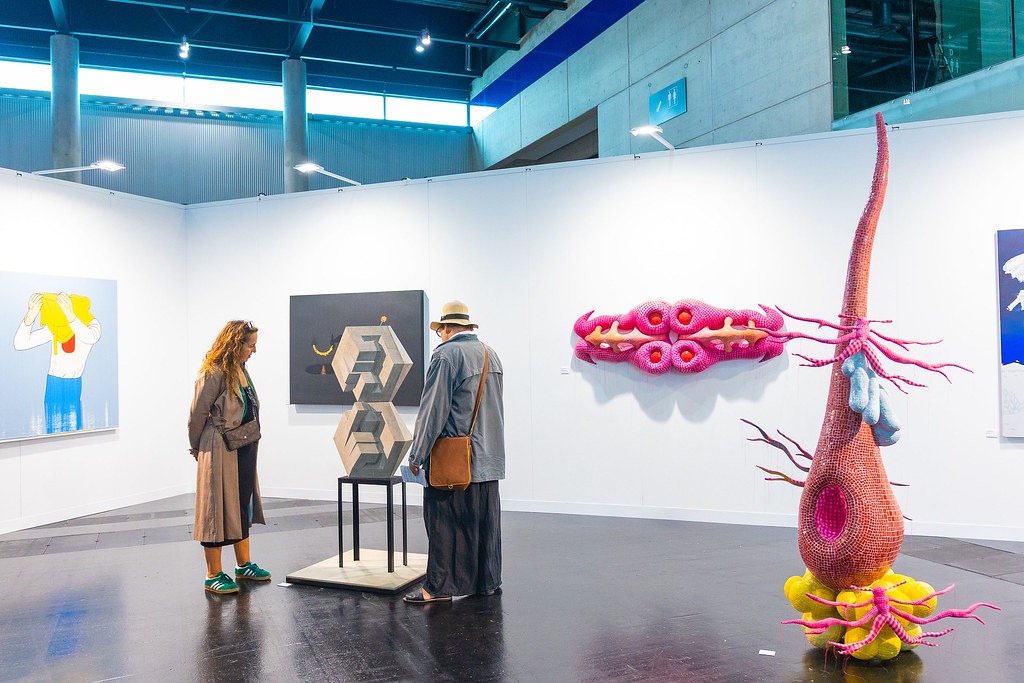
viennacontemporary 2025: Expanding Narratives
Notes on viennacontemporary 2025
It is noteworthy that the 11th edition of viennacontemporary opened its doors on September 11—a date etched in our collective memory as 9/11—and just a day after the Russian drone incident in Polish airspace. The fair, both directly and symbolically, reflected the changes the world—and each of us individually—are facing today. It also sparked a discussion about the paradigm shift of the art fair as an institution: its role, its adaptation to the new reality, and the values and responsibilities it embodies.
Just as each of us is confronting fundamental questions, so too is an art fair: What is its place not only in the art world but also in the broader social ecosystem? What kind of message will it convey? What continuity exists beyond the four days it physically takes place? And what is, or will be, its position in Vienna and the region—especially considering Vienna’s central geographic location? The fair truly stands at a crossroads; from Vienna, for example, it is approximately a 1.5-hour flight to both Riga and Athens.
Sophie Tappeiner at the viennacontemporary 2025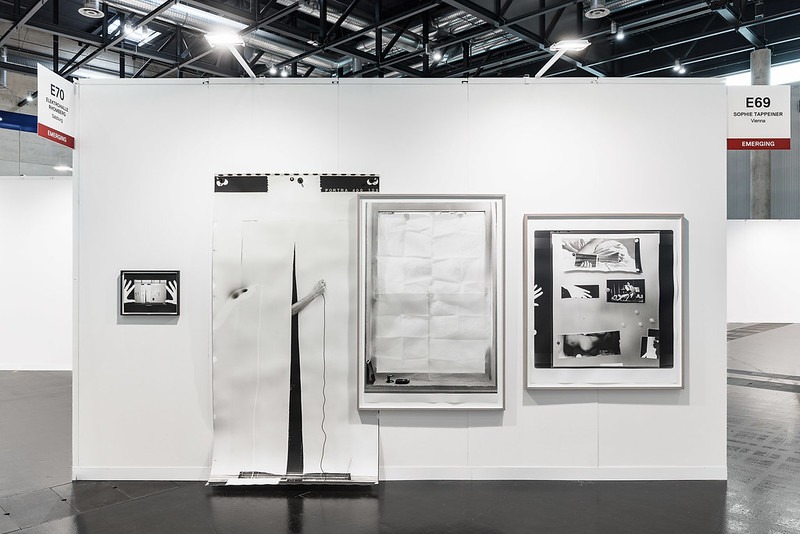
According to official statistics, the 11th edition of viennacontemporary brought together more than 350 artists and 102 exhibitors from 23 countries. Nearly 40% of the presentations came from Central and Eastern Europe, affirming viennacontemporary’s position as the foremost international platform for this region. Equally significant, the Emerging section was the fair’s largest to date, marking a decisive commitment to the visibility of new galleries and the introduction of artists shaping the next chapter of contemporary practice.
Over 15,000 visitors—including leading international collectors, cultural figures, and influential members of Austrian political, economic, and cultural institutions—gathered at Messe Wien for four days of exchange, discovery, and dialogue.
Photo: (c) Anastasiia Yakovenko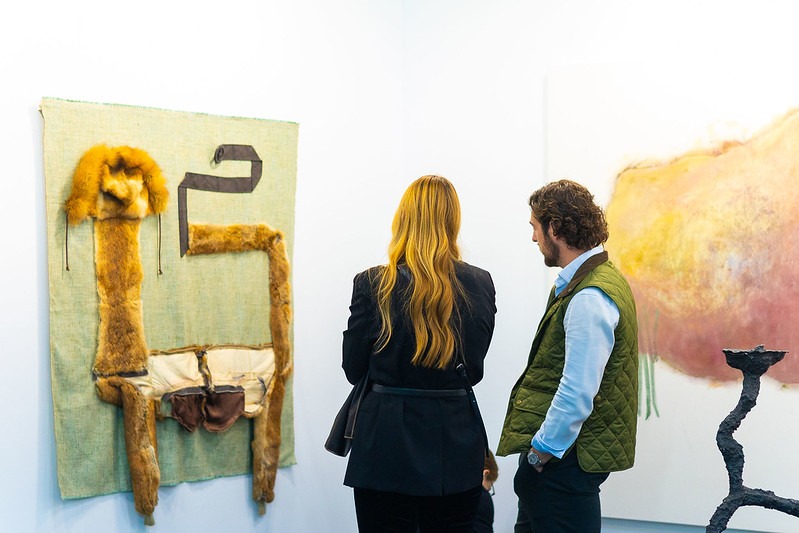
While the location of the fair remained the same as in previous editions—Messe Wien—its energy has completely transformed. This was the first fair under the artistic direction of Abaseh Mirvali, whose appointment marks a paradigm shift in the fair’s positioning.
Abaseh Mirvali, a distinctly multicultural personality—of Persian descent, raised in the US, with extensive experience working in Mexico, the US, and Europe—has brought to viennacontemporary not only her professional vision but also an energy deeply shaped by her life experiences. Perhaps it is precisely this combination—a strong professional vision, extensive experience in diverse countries and cultural contexts, and immense work capacity—that has provided the necessary impetus for viennacontemporary, an art fair with long-established traditions, to take a leap forward and begin a completely new chapter without losing its roots.
“For me, the role of the art fair—coming from the non-profit side in all my beginnings, and this being the first time I am not at a museum or a non-profit cultural institution—is that it represents another important player in the ecosystem. Like museums, independent spaces, and various projects, we are all working to foster greater dialogue.
Of course, the fair’s primary clients are the wonderful galleries participating, along with the artists they represent and their collaborators. But I also believe it is part of a broader discussion about the cultural community we are trying to support—not only here in Austria but across the wider region and in dialogue with the international community. That has been my focus, and everything we have done here aims to expand narratives, which I hope naturally also translates into the commercial side,” says Abaseh.
Christine König Galerie at the viennacontemporary 2025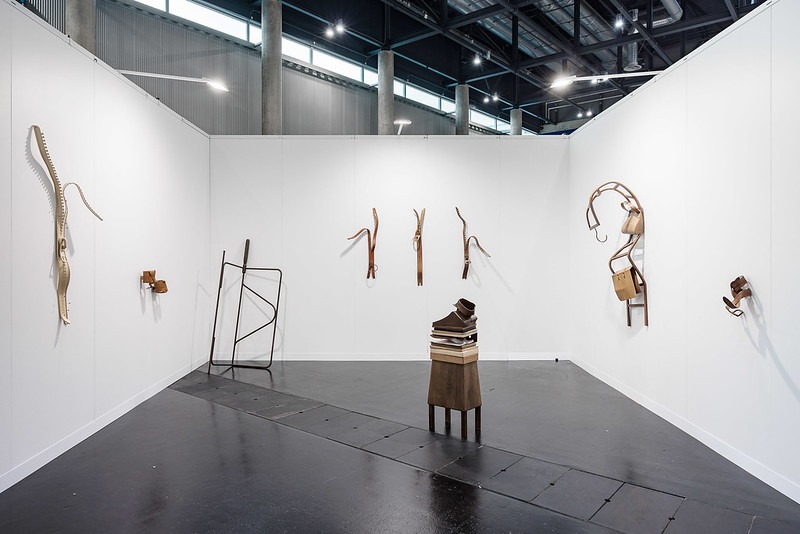
She adds, “It wouldn’t have been possible without the tremendous guidance, support, and collaboration of all my colleagues, as well as the greater community in Vienna and abroad, who made it possible to bring this together.” As Abaseh also noted during the opening press conference, she began working on this edition of viennacontemporary “only five months and 11 days ago.”
“I think those of us who work in the cultural community—and that is a vast network, from the most visible figures to writers and many others—do it because we deeply believe in what art can convey, and in the work we do within the cultural community to support different dialogues and perspectives.”
The very first change, which decisively shapes the experience of this year’s fair, lies in the architecture of the space. Abaseh Mirvali entrusted this task to architects Claudia Cavallar and Lukas Lederer, recipients of the Hans Hollein Art Prize for Architecture 2025. While the fair remains in the same venue as last year, the atmosphere has been completely transformed. The new design introduces a sense of openness and transparency and, most importantly, creates both a physical—and at times, a metaphysical—space in which artworks can truly “breathe.”
Photo: (c) Jakob Kotzmuth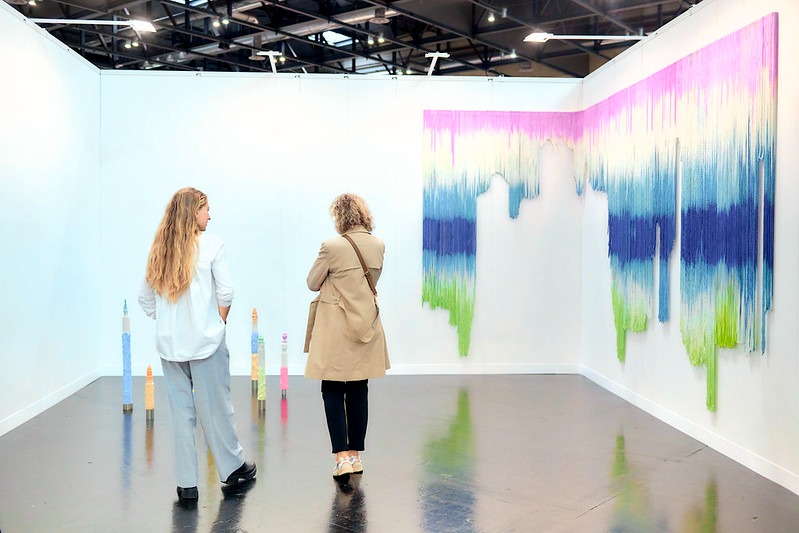
Art fairs, undeniably commercial by nature, yet aspiring to something closer to the ideal once embodied by the ancient Greek agora, have always faced the challenge of designing a space where both visitors and artworks can truly breathe. Cavallar and Lederer have answered this challenge with notable success. Their architectural vision not only deepens the encounter between viewers and art but also enhances circulation throughout the exhibition hall, with carefully planned navigation and distinctive “anchor points” that structure and orient the experience.
One of the first gallery booth to catch the eye at the fair—and one that sets the standard for quality and continuity—is Galerie Krinzinger. A flagship of the Viennese art scene, it is among Austria’s most legendary and representative galleries, founded by Ursula Krinzinger.
Marina Abramović, The Spirit in Any Condition Does Not Burn, 2011, c-print, 172 x 142 cm, © Marina Abramović / Courtesy Marina Abramović Archives
This year, Galerie Krinzinger presents a compelling portfolio reflecting both the international art world and the local Viennese scene. At the same time, it underscores the gallery’s significant role in the wider art ecosystem, as many of its artists are regularly featured in major institutions such as the Albertina. The booth includes a work by Tony Schmale, who was honored with a solo exhibition at Albertina Modern last year, as well as works by Marina Abramović, whose retrospective will open at Albertina Modern on October 10 and run until March 1, 2026.
Monica Bonvicini, Time to Go, 2024, clocks, stainless steel, aluminium, 28 x 28 x 28 cm
Also on view is a work by Eva Schlegel, whose large-scale installation The Wing of the Dragonfly—composed of 3.5 million beads and 2,000 strings—will be unveiled in the foyer of the Leopold Museum in early October.
Toni Schmale, circlusion kleine metallarbeit ***, 2025, steel forged, waxed, 145 x 100 x 18 cm, courtesy Galerie Krinzinger / Photo: Tamara Rametsteine
In this way, the Galerie Krinzinger booth serves not only as a highlight of the fair but also as a reflection of the currents shaping both the Viennese art scene and the international art world at large.
Not far from there is the Hungarian acb gallery, a long-standing collaborator with viennacontemporary, which this year presents emerging voices—a snapshot of the current moment. Robert Batyko (b. 1981) investigates the impact of digital image processing on our visual culture and the hypnotic power of consumerism, expressed in a comic-style abstract language that examines how we are shaped by manipulative and transformative processes.
acb is also exhibiting works by sculptor and installation artist Zsófia Keresztes (b. 1985), whose objects blur the boundaries between virtual and real identities. These hybrid forms merge organic structures, oscillating between sensuality and impersonal self-sufficiency, their glistening surfaces evoking both the digital and real worlds in tones reminiscent of high-street candy stores—artificial yet inviting. The works absorb a wide range of references and fragments of reality, embodying duality and fragility: the organic and the artificial.
Kow Berlin, meanwhile, is exhibiting works by Franz Erhard Walther (b. 1939), known since the 1960s for his participatory, action-oriented sculptures. “He became famous for developing works in which the viewer could become a user of the piece, and in that sense, also a creator. The work does not exist solely in the object you see, but also in the handling and use of it,” explains Nikolaus Oberhuber, one of the gallery’s co-owners.
The artist himself often emphasizes: “Sculpture doesn’t need the eye.” The assemblage of Walther’s works on display can be viewed and purchased as a complete set, but visitors are invited to rearrange the constellation according to the architecture of the space. “This is one idea, one proposal,” adds Oberhuber, “but the concept is that you can create a new image by interacting with and reconfiguring the work.”
This year, ten galleries from Poland were represented at viennacontemporary 2025, subtly bringing geopolitical realities into play. Agata Smoczynska-Le Guern, founder of Warsaw gallery Le Guern, recalls that on the day she was scheduled to fly to Vienna, Warsaw’s airspace was closed. For several hours, it was uncertain whether she would arrive in time to set up her stand.
At the same time, Smoczynska-Le Guern acknowledges that crises can have a mobilizing effect. Paradoxically, the Warsaw art scene gained new momentum during the pandemic. In a sense, staying at home became a catalyst for market development, as people increasingly recognized the importance of art in their daily lives.
Among other highlights, Le Guern’s stand features ceramic works by Aleksandra Liput. As Smoczynska-Le Guern notes, ceramics have been gaining popularity in the Polish art scene in recent years. Yet they remain a complex medium for collectors, partly due to the lingering perception of these works as fragile.
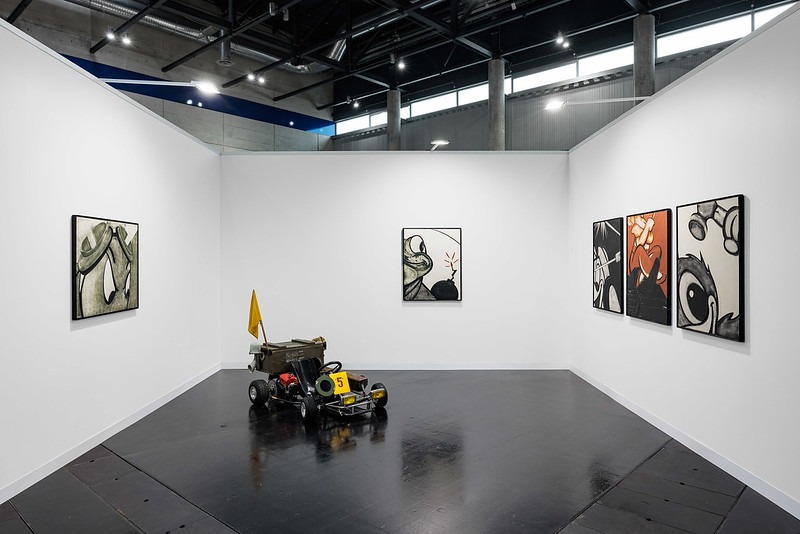
Meanwhile, Galerie 422 from Salzburg spotlighted experimental woodcut painting at its booth. Through works by Gunter Damisch, Lena Goberl, and Maximilian Bernhard, the gallery demonstrated how a technique once primarily used for reproduction is now being reimagined as a tool for individual expression.
Brugger Gallery at the viennacontemporary 2025 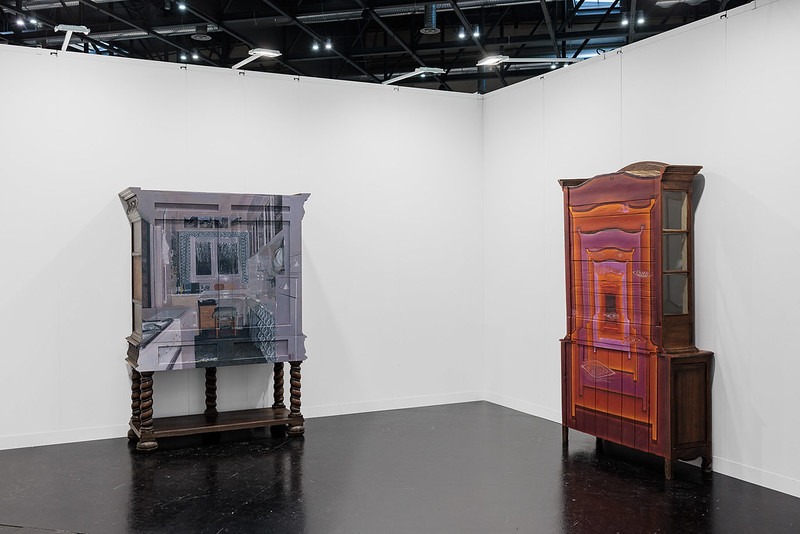
Perhaps it is precisely the complexity and uncertainty of our times—which, according to several gallery owners and artists I met at the fair, has influenced both market trends and the general mood—that has paradoxically inspired bold expressions of humor, color, and optimism. In this context, art serves as a reminder of the power of joy and positive emotion, even when the outside world feels bleak.
At Galeria Sophia Vonier, the booth is awash in red. “For the first time, I decided to present almost my entire program—12 works—in red,” explains gallery owner Sophia Vonier. “I wanted a cohesive, curative aesthetic for the booth. There are absolute highlights, including works by Marianne Vlaschits and, for the first time, a piece by Elisa Alberti.”
Driton Selmani, LOST FOR WORDS
Photo: Atdhe Mulla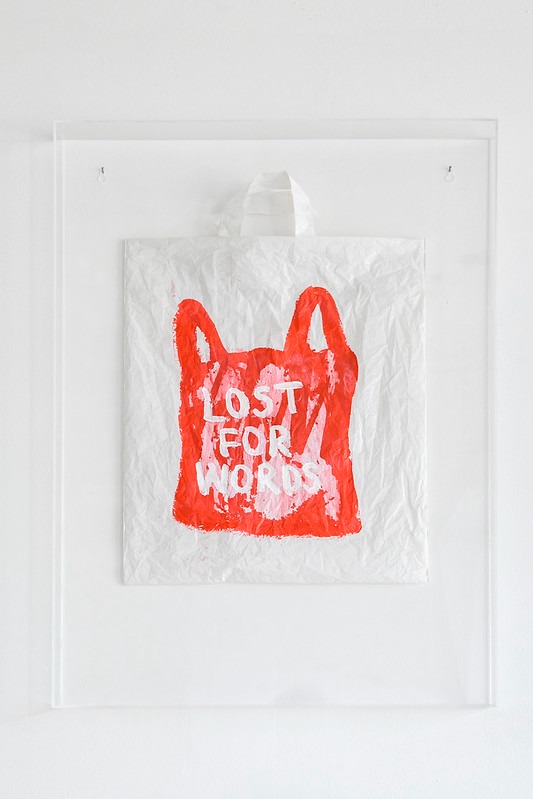
At Galerie Hilger, Driton Selmani transforms everyday objects into thought-provoking statements. Framed plastic shopping bags bear phrases that capture the rush of daily life and reflect dreams, doubts, hopes, and environmental anxieties: “Daydreaming is my part-time job,” “Paradise as a promise is just around the corner,” “I complain therefore I am,” “Dreams have deadlines.” Each piece merges the mundane with the reflective, inviting viewers to pause and consider the unseen weight of routine thoughts.
Sophie Tappeiner at the viennacontemporary 2025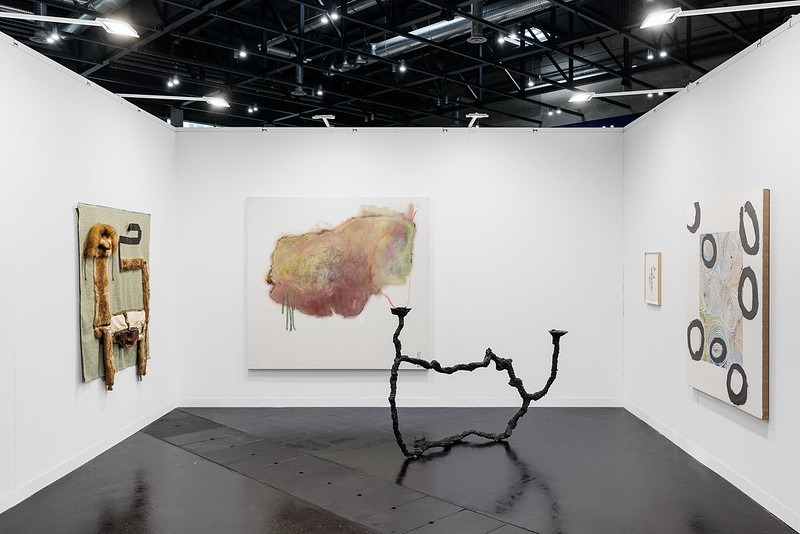
Meanwhile, the Sandwich Gallery from Bucharest delights visitors with Cats Are Taking Over. The exhibition playfully reflects the absurdity of social media life, offering a humorous, ironic commentary on Instagram culture through exuberant feline expressions.
Kim? gallery at the viennacontemporary2025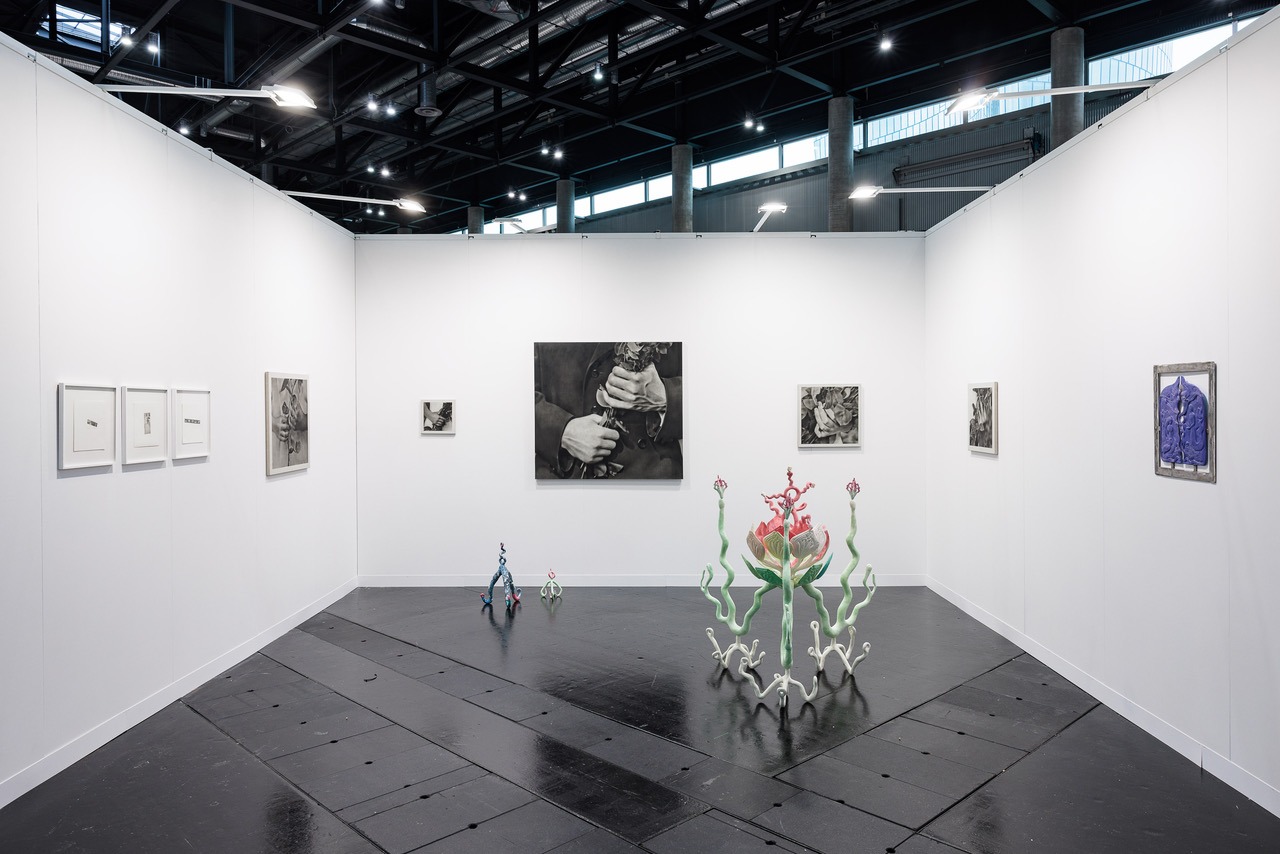
For the first time in the Emerging Gallery sector, Riga’s Kim? Gallery presented works by Krista Vindberga and Anna Egle. The gallery’s debut was also commercially successful, selling four works for €7,800 to a mix of museums, advisors, and private collectors, with further discussions ongoing.
Kim? gallery at the viennacontemporary2025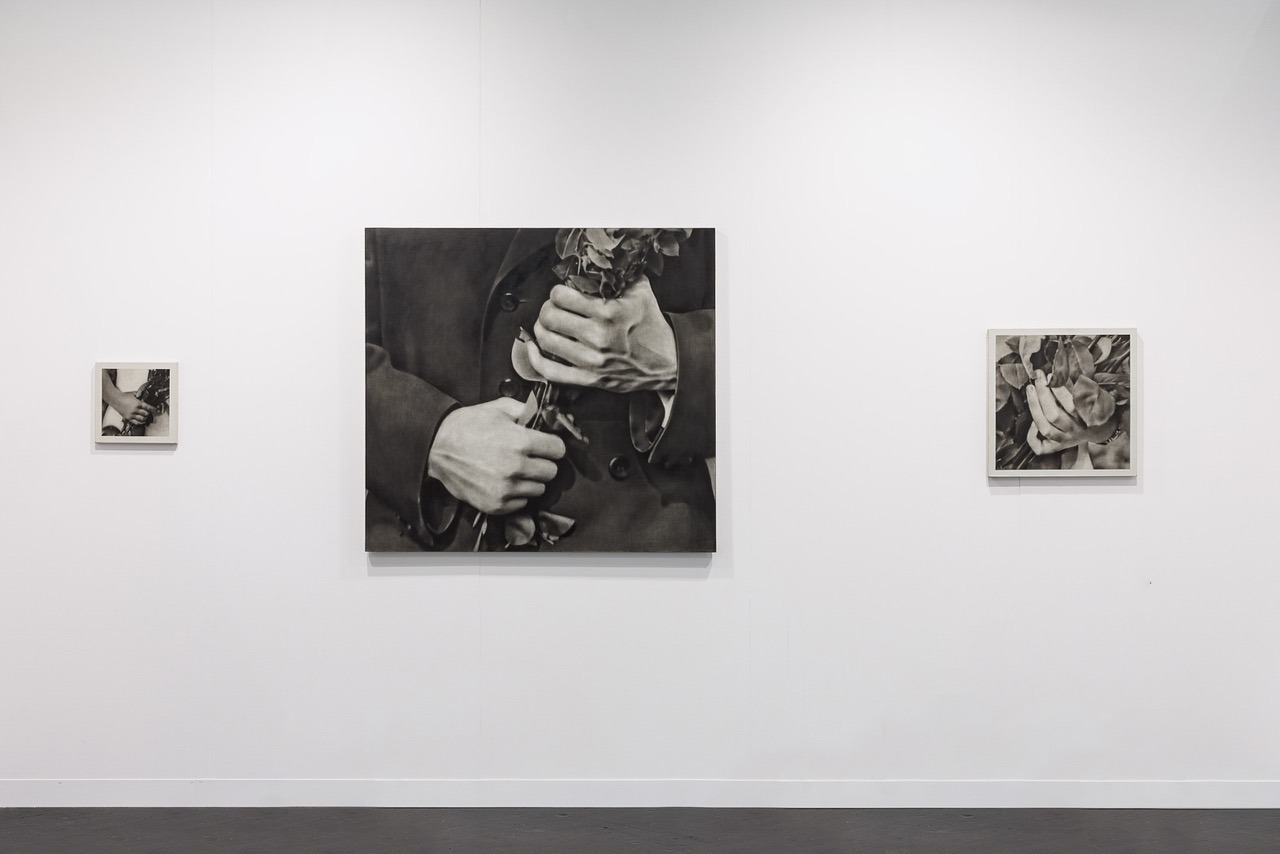
Krista Vindberga, present at the fair, remarked: “These incredibly intense days at viennacontemporary flew by quickly and were immensely fruitful. Conversation lay at the heart of it all, becoming the core of the experience. I am infinitely grateful to Kim, Dārta Purvlīce, and Evita Goze for taking care of the works, supporting me, and ensuring that the conversations flowed smoothly. For the first time, I created entirely new works for this event, which made the experience particularly special. It is always important to see your works in a broader context and observe how they appear in a completely different environment from what is usual in Latvia.”
Fabian Reetz,
EGGS (a monument to the ruined days). Photo: Klockermuseum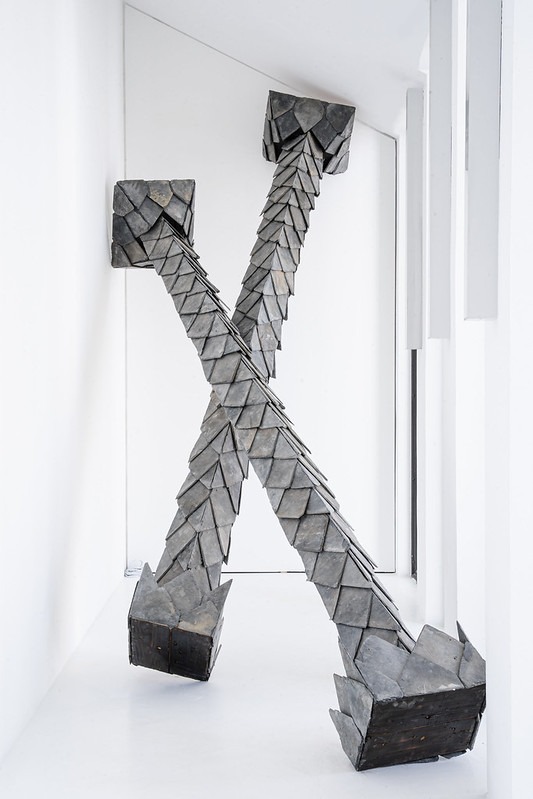
The combined energy of viennacontemporary 2025 also translated into strong sales results. According to official figures: Galerie Zimmermann Kratochwill confirmed sales for €120,000. JECZA (Timișoara / Bucharest) sold ten works, six of them finalized during the fair, for €59,000. Sophie Tappeiner reported sales of three works amounting to €43,000, with further interest expressed at closing. Elektrohalle Rhomberg (Salzburg) achieved remarkable success, selling four works by Haruko Maeda in the range of €7,700–22,000, as well as five works by Ester Paraskova for a total of €35,000. Giorgio Persano (Turin) sold a major painting by Michelangelo Pistoletto for €25,000 and a large-scale work by Per Barclay for €20,000 to a private collector. Galerie Elisabeth & Klaus Thoman (Vienna) sold three works priced between €3,000 and €30,000, with additional institutional interest pending. Galerie Sturm & Schober (Vienna) reported sales of around €25,000 to private collectors and noted “finally an upswing” in the general atmosphere of the art market. Galerie nächst St. Stephan Rosemarie Schwarzwälder (Vienna) recorded the sales of works by Christoph Weber, Konstanze Stoiber, and especially the recently deceased Herbert Brandl. Victor Lope Arte Contemporaneo (Barcelona) placed three works by Clara Adolphs, two by Concha Martinez Barreto, and a sculpture by Mario Dilitz in the price range of €5,000–15,000 each. Galerie Ernst Hilger (Vienna) closed six sales of Kosovarian artist Driton Selmani between €5,000 and €7,000 each. Christine König Galerie (Vienna) sold four works from their solo presentation of emerging artist Tobias Izsó for €3,000–7,000 each, with two further reservations pending. Little Bird Place (Sofia) placed seven works by Nora Ampova and Lyuben Domosetski for €19,000. Himera from Timișoara reported sales of eight works totaling €15,000, while WHOISPOLA (Warsaw) sold a major painting by Julia Woronowicz for €10,000 to a private collector. COMMA Gallery (Bratislava) sold four works on the first day – two each by Ivana Šáteková and Kristián Németh – in the €1,000–2,000 range. Spline Art (Kyiv) sold a painting for €6,000 and a sculpture for €1,200 by Alexander Kryzhanovskyi. KROBATH (Vienna) also reported strong results with several works sold in the €2,000–20,000 range to both local and new international collectors.
Hermann Nitsch HN/M 277 "Schüttbild mit Malhemd“, 1995 oil and blood on canvas, 190x300 cm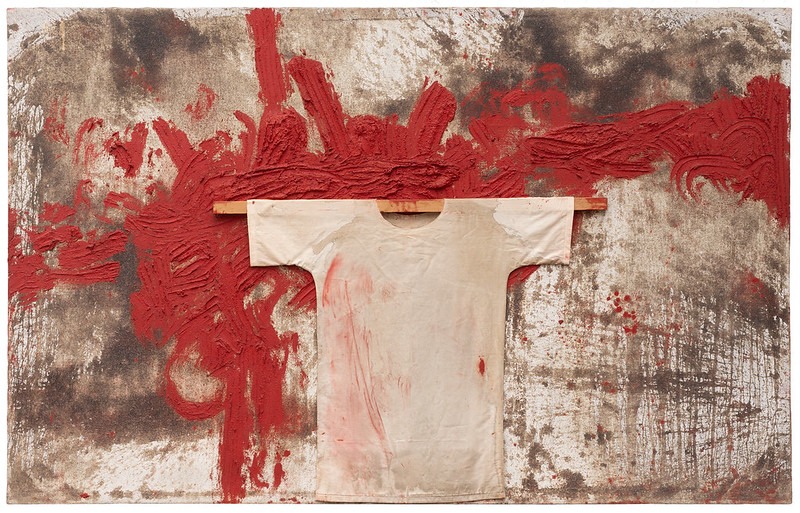
Several art awards were also presented. Both the inaugural Münze Österreich Prize and the viennacontemporary | Bildrecht SOLO Award 2025 were awarded within ZONE1, curated by Aliaksei Barysionak, a platform for emerging artists with ties to Vienna and Austria.
The Münze Österreich Prize, in cooperation with Münze Österreich and the MAK – Museum of Applied Arts Vienna, awarded €35,000 and a solo exhibition at MAK in 2026 to Kateryna Lysovenko (UA), represented by first-time participant TBA Gallery (Warsaw). This prize supports mid-career artists, providing both resources and institutional visibility.
The viennacontemporary | Bildrecht SOLO Award 2025 was presented to Natalia Sýkorová (SLO) and VUNU (Vienna / Bratislava / Košice), recognizing outstanding solo presentations emphasizing concentrated artistic inquiry.
Lukas Thaler. Seating variations (bench #1 #2 #3), 2025.engraved limestone, nitro-acrylic lacquer, polyurethane resin
bench #1: 58 x 60 x 170 cm; bench #2: 58 x 49,5 x 190 cm,
bench #3: 58 x 52 x 190 cm
unique
:copyright: Galerie Elisabeth & Klaus Thoman / Marlene Mautner
Courtesy the artist and Galerie Elisabeth & Klaus Thoman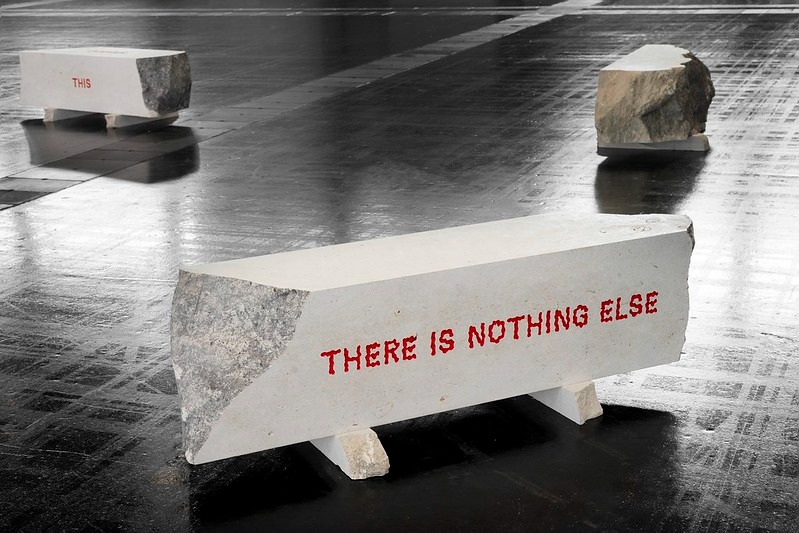
JP Immobilien enriched its collection with Seating Variations by Lukas Thaler, winner of the Sculpture Project 2024, represented by Galerie Klaus & Elisabeth Thoman. Positioned at the heart of the fair, the installation served as a central meeting and orientation point. Thaler explains: “I was invited to produce a sculpture for public space in Vienna. The result is a group installation using limestone, a material visible throughout the city, including the Parliament building, carrying strong symbolic presence. I wanted to create something different with this historically and politically loaded stone, producing sculptures that look like a monument in the making—or perhaps already dismantled, lying around. The pieces contain engraved fragments of sentences and words—vague, ambiguous, public, in-between—rather than slogans, inviting reflection on what monuments can be, could be, or once were.”
Lukas Thaler. Seating variations (This changes everything), 2025, engraved limestone,
58 x 52 x 190 cm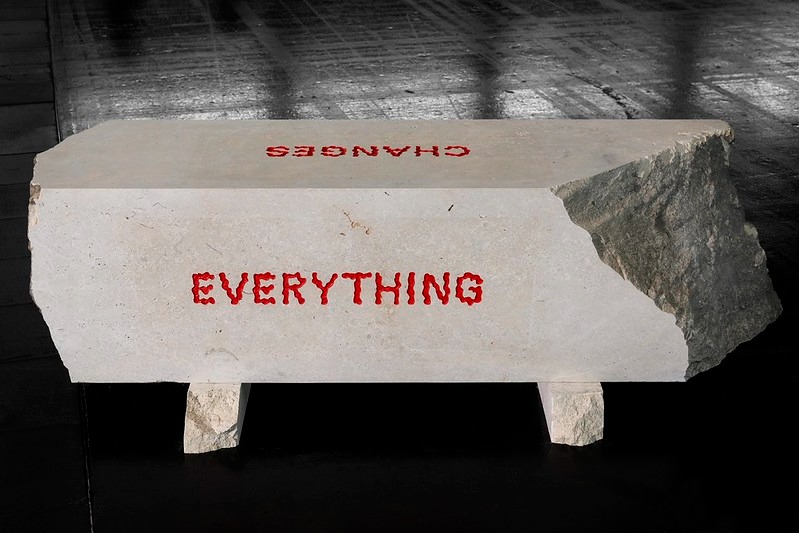
The 2025 edition was deeply engaged with Vienna and Austria’s cultural and civic landscape, affirming the fair’s role as both an international platform and a local interlocutor. This vision was articulated through three curated sections: STATEMENT, organized by Marcella Beccaria with ERSTE Foundation; CONTEXT, curated by Samantha Ozer; and ZONE1, curated by Aliaksei Barysionak with BMWKMS. Together, they offered frameworks for exploring urgent artistic positions across generations and geographies.
Zhanna Kadyrova, RUSSIAN ROCKET PROJECT, 2022-ongoing, video without sound, video stills. Courtesy of the artist and GALLERIA CONTINUA. @russian.rocket.2022 on IG.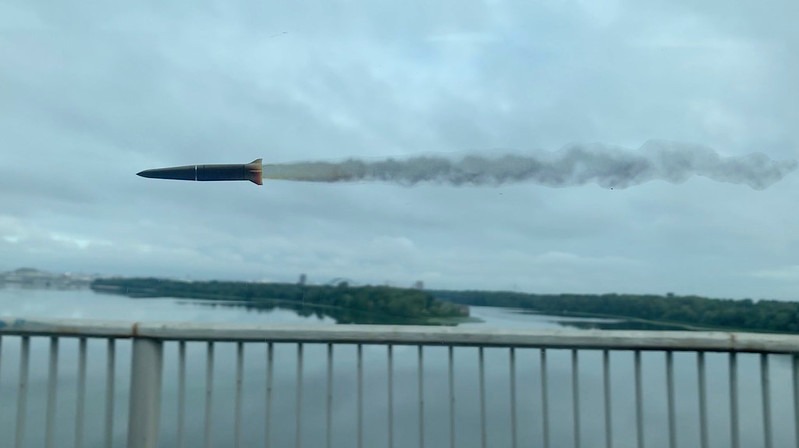
For the first time in viennacontemporary’s history, thanks to Abaseh Mirvali’s artistic vision, the STATEMENT exhibition was held in a separate space above the fair’s central hall. This presented a challenge, as changing visitors’ habits is never easy. Although on the opening day there was still a noticeable difference in attendance between the STATEMENT exhibition and the main hall—likely due to limited signage and ingrained visitor routines—this approach has ultimately proven its worth.For the first time, the STATEMENT exhibition took place in a separate space above the central hall of the fair.
The exhibition, curated by Marcella Beccaria and titled Realities Building, featured artists Zhanna Kadyrova, Agnieszka Kurant, Armando Lulaj, Oscar Muñoz, Joans Staal, and Cally Spooner, and focused on algorithmic control, digital disinformation, and technological manipulation. Its strategic location on the upper floor allowed the exhibition to become a space for reflection, encouraging visitors to consider the ambiguous and complex aspects of the reality that surrounds us, while simultaneously adding value to the fair itself—many of the conversations initiated there gained additional depth as a result.
Agnieszka Kurant. Post-Fordite 13, 2025. Fossilized automotive paint, epoxy resin, powdered stone, steel, on pedestal; 21.6 x 25.4 x 25.4 cm;Courtesy of the artist and Marian Goodman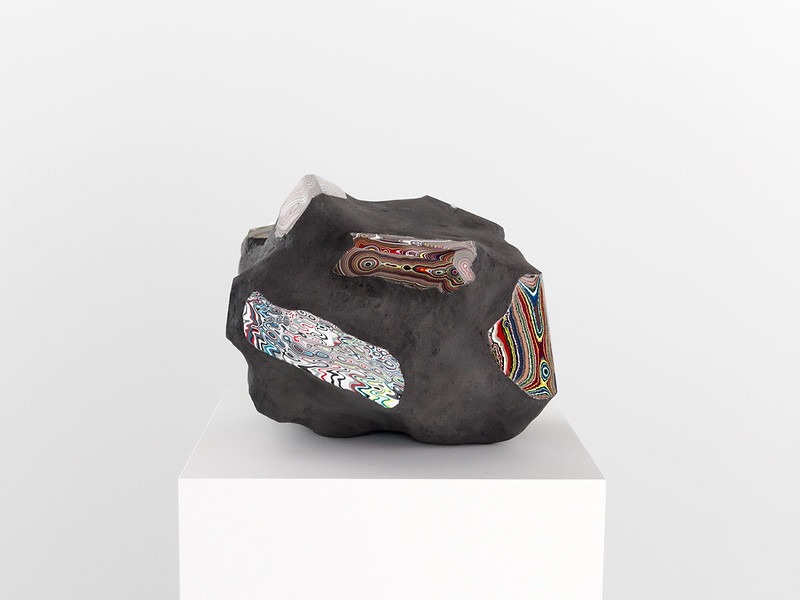
In this context, I would like to highlight Agnieszka Kurant’s work Chemical Garden, a processual installation in constant flux, composed of chemical substances used in the digital technologies that permeate our daily lives. As Kurant explains, she placed these substances into the seemingly aesthetically beautiful cube, filled with color and texture, only the day before. Dominating one another and interacting, they filled the cube like sirens’ chimeras overnight. Their movements are unpredictable, yet undeniably directed toward dominance. They lack empathy, embodying only a programmatic attitude, offering a glimpse into a world that is both created by us and yet lives independently. Normally invisible to our eyes, this world shapes our reality and the systems through which information flows daily, influencing our lives.
Agnieszka Kurant. Chemical Garden, 2021/2025. Sodium silicate, copper, nickel, cobalt, chromium, manganese, iron, zinc salts, 141 x 30 x 30 cm; Courtesy of the artist and Marian Goodman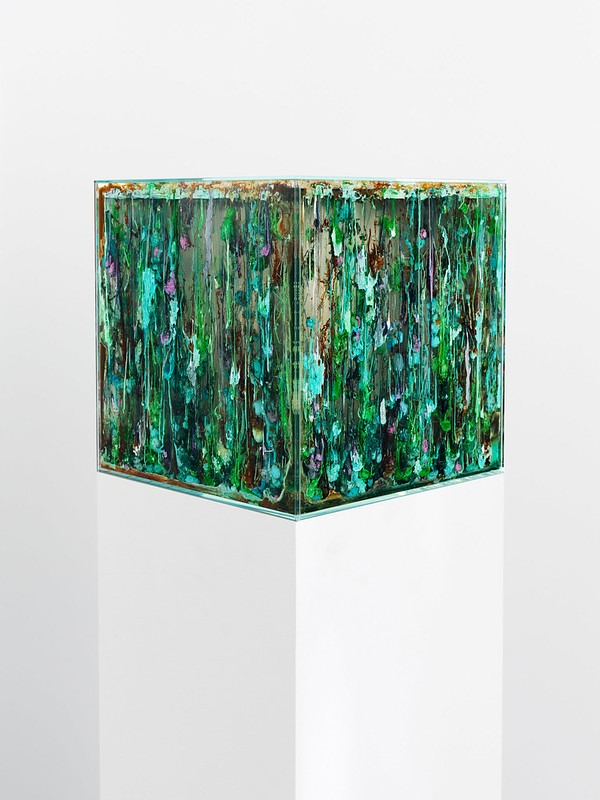
The second work by Agnieszka Kurant is an object whose edges are polished like mountain crystal. As the artist explains, these are fragments of flooring once found in car factories—essentially decades-old car paint patina that workers took as souvenirs when leaving the factories. Ironically, now that car factories are robotized and cleaned by machines, achieving near-sterility, the value of these artifacts from days gone by has risen significantly.
Perhaps it is precisely this combination of humanity and human interaction, openness to dialogue, and a strong sense of vision and professionalism that has defined the success of viennacontemporary 2025.
Photo: Niko Havranek